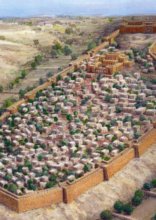In Jewish Sites
A Trip Through History - Chapter 5
A visit to ‘Ir David’ – David’s Village – is a voyage into the mists of time, which takes the visitor back thousands of years
We are now continuing into another tunnel, which emerges from the large rainwater-collection pool which is at the centre of the four fortresses. This tunnel leads to the Gichon spring. A giant water-clock now faces us, and the darkness envelops us. This is one of the springs that flows through the hills of Yehudah. It is called the Gichon owing to how its waters flow in bursts [gach]. The source of the spring is found under the descending steps. In Sefer Melachim, this spring is attributed as being that where Tzaddok haKohen anointed Shlomo haMelech, when all the people proclaimed “Long live the King Shlomo.”
From the place from where the spring emanates it runs through a gulley that was hollowed out for it and then emerges from, a tunnel whose length is more than a half kilometre. This is the tunnel of Chizkiyahu the King of Yehudah. And so it states in Sefer Divrei haYamim; “And Chizkiyahu stopped up the upper source of the Gichon waters, and directed them downwards towards the west to Ir David.” That occurred during the siege imposed by Sancheriv, the King of Ashur, on Yerushalayim. Part of the preparations for the defence of the city before the siege began was the strengthening of the fortifications of Yerushalayim, undertaken by King Chizkiyahu - he also encircled the new neighbourhoods of the city with walls. In addition, Chizkiyahu redirected the waters of the Gichon spring to a pool within the walls of the city.
When were the waters redirected? A long conduit was excavated to carry the waters along it – it was 533 metres in length and was an amazing feat of engineering. None of those involved in its excavation have any idea how it was constructed or how the upper tunnels were hollowed out – they were clearly the works of master craftsmen. There is only one account that has survived to the present day from those times, describing the construction of the tunnels.
This is an inscription in ancient ksav Ivri, which was discovered 125 years ago, approximately six metres from the Shiloach pool. The inscription attests to the unbelievable level of craftsmanship that existed in such ancient times, long before there existed any forms of electric machinery to assist in the labour. In addition, two separate groups of workers excavated the tunnel from opposite directions, and then met up with each other in exactly the correct location, under the earth, without utilising any of the methods that exist today in order to determine their relative location.
The inscription is today located in a Turkish museum – on it is written; “[unknown word] digging. This was the matter of the digging. When [the diggers were still hammering with] their axes, towards each other, three amos were left to excavate, the voice of one digger [was heard] calling to his friend since they were to the left and right of the [remaining] rock. On that day the diggers knocked through to each other, axe to axe, and the waters flowed from their source to the pool, one thousand two hundred amos away, and the diggers had excavated at a depth of a hundred amos under the rock.”
Amazing. The workers who carried out this excavation, deep beneath the earth, built a paved and twisted tunnel, not a straight one, and despite this they succeeded in reaching each other exactly in the middle. How did the workers calculate the alignment of their place of meeting?
And if this is not incredible enough, another question presents itself, which deals with those ancient days, many more than two thousand years ago; how could they have excavated such a narrow tunnel with no source of air, no oxygen and no lighting? Candles or oil lights would not have been able to illuminate such work, since they would have drawn on the limited supply of air in the space being worked in. And indeed, along the whole length of the tunnel, there is no trace of any form of socket in which any form of lighting could have been placed.
The answers to these questions are unknown. It appears that we will have to wait until the excavators and those who directed them will be revived at Techiyas haMeisim, and then they will reveal the answers to these mysteries.







